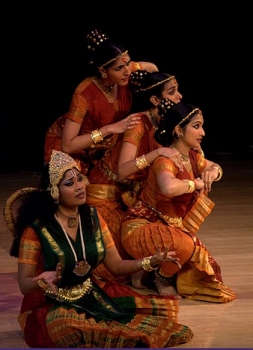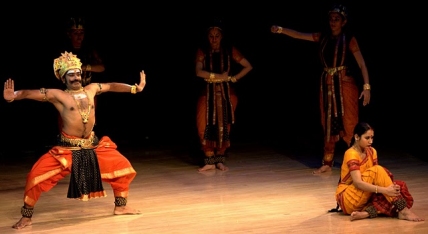
|   |

|   |
A visual and an aural delight - Sulakshana Jayaram, Chennai e-mail: sulakshana.jayaram@gmail.com Photos: Badri Ramasubramanian July 15, 2011 The recently concluded eleven day Cleveland Thyagaraja Aradhana Festival, now in its 34th year, showcased top notch music and dance performances by great exponents and gave the rasika the opportunity to soak up a holistic and sublime experience of divine rasanubhuti. In a collaborative effort of considerable proportions that involved dancers and musicians from India, United states and Muscat, the magic of the eternal classic, The Ramayana, was brought to the fore in a delightful Bharatanatyam dance drama. Presented as a series of performances, the ‘Ramayana in five parts’ was a remarkable and pioneering initiative by the Cleveland Aradhana committee, promoting and nurturing the cultural curiosity and education amongst the Indian diaspora. Indian children in the United States researched the epic and authored the storyline with their perspective.  The Kishkinda Kandam and the Sundara Kandam presented on the ninth day of the festival was a delectable treat both for the aficionado and the uninitiated alike. Choreographed by Guru Anita Guha, who has won immense critical acclaim for her other home productions, the production was a remarkable tapestry of ingenious visualization and immaculate articulation through the dance vocabulary. The music composed by Neyveli Santhanagopalan was as if twin born to the dance! The inextricable unison between the dance movement and the accompanying music made the entire viewing experience a canvas of a visual and aural delight.  The mandate was to present the dance drama in the traditional Margam format, making it a challenge to retain the dramatic fervor and continuous narrative through the entire production. As a masterly stroke for music, we had Sahitya Jathiswaram, a modified version of the traditional Jathiswaram combined with the sabda, Lakshmana Ramayanam in a Varnam format and the Thillanas to depict the Vanara episodes. The Mallari used to portray the Asuras in Lanka was a piece de resistance for its sheer novelty in choreography showing the peculiar idiosyncrasies of the Asuras. The sequence showing Rama's supreme prowess and skill in archery when the trajectory of his single arrow pierced through seven sal trees was brilliant; dancers became the trees who swayed ever so gently when pierced by Rama's arrow. The Kishkinda Kandam and the Sundara Kandam are intrinsically most dramatic; while the entire dance production was steeped in high drama quotient, what was pure joy was how the subtle nuances of the characters were beautifully captured, catapulting the viewer right into the middle of all the drama. While one saw Rama's valor, prowess and righteousness, his love for Sita, and his vulnerability and angst at being separated from her were shown in equal measure. Sita was etched with sensitivity and grace - as an epitome of the uttama sweeya nayika - who would not even throw a glance at a para purusha. The deliberate refrain from using rhythm while showing Sita was a beautiful musical touch. While the dominant mood in both the kandams presented is sombre and has an undertone of tremendous anticipation, the seemingly effortless use of a touch of humor in the delineation of the events was brilliant, thus avoiding a monochromatic canvas of mood and emotion. Whether it was Ravana ‘showing off his biceps’ to brother Vibheeshana, or Lankini's encounter with Hanuman replete with her getting ‘knocked out and going cross eyed,’ or Hanuman ‘peeping through the foliage in the Ashoka Vanam to eavesdrop’ into Ravana's conversation with Sita, all were most convincingly interspersed with in the sequences. The casting was apt and all artistes brought to life the characters from the classic.  Janaki Rangarajan as Rama had a quiet aura of beauty, strength and dignity, while Aishwarya Narayanaswamy breathed life into her Guru's sensitive visualization of Sita. Sumithra Subramanian as Lankini and Thiruchelvam as Vali and Ravana were scene stealers for their respective brilliant portrayals. Sangita carried off Hanuman with aplomb even when she was required to just pry and peep from behind the stage curtains to see what transpired in the Ashoka vanam! Priya Ramdas as Tara, Bhavajan as Sugreeva, Yatin as Indrajit and Sampadi, Sangita Vasudevan as Jambavan and Dhyanamalini and all other dancers in their respective roles lent to the success of the production in full. The accompanying music had a transcendental quality to it with musicians of the highest calibre. Guru Anita Guha wielded the cymbals and endeared herself to the audiences especially as she took the audience by surprise and provided the voice for Ravana’s terrifying laugh. As the main vocalist, Sriranjani Santhanagopalan's music rendition was most evocative. Nisha Rajagoplana and Gayathri Venkataraghavan contributed more excellence. The other members of the orchestra who provided brilliant support included Nagai Narayanan on the mridangam, R Thyagarajan on the flute, Ranjani on the violin and Bhargavi on the Chitraveena. What echoes long after in my mind is “Entha Madhuram Rama Namam, Entha Madhuram Ramayanam.” Trained in the Pandanallur bani, Sulakshana has given over 200 solo recitals since her arangetram at the age of ten. She is an accredited ‘A’ Grade artiste with the national television Doordarshan and is empanelled with the ICCR. She was also a proud recipient of the cultural scholarship since 1990 for ten continuous years and a production grant for an original creative production, by the Ministry of Culture. She has performed for major dance festivals in India. |